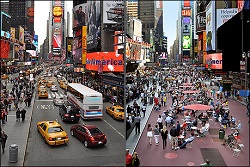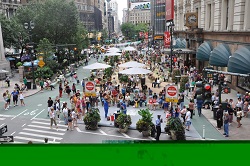Reclaiming Broadway's Public Space
New York City, New York
Originally written by Marissa Miano, UNC Highway Safety Research Center (2010) and updated in 2012 by Jill Mead, University of North Carolina Highway Safety Research Center.
New York City, New York
Originally written by Marissa Miano, UNC Highway Safety Research Center (2010) and updated in 2012 by Jill Mead, University of North Carolina Highway Safety Research Center.
For years, traffic congestion and pedestrian injuries and fatalities plagued Broadway in midtown Manhattan, a destination for tourists and residents alike. In spite of the high volume of pedestrian traffic, locations along Broadway, such as Times Square, provided minimal space for people to circulate.
Previous improvements to pedestrian facilities in New York City have increased pedestrian safety. Furthermore, the need to tackle problems such as inadequate public spaces and insufficient amenities for pedestrians and bicyclists led to the 2007 adoption of PlaNYC: A Greener, Greater New York, a long-range, comprehensive plan to address economic, social, and environmental concerns facing the city's five boroughs. As part of this effort, the New York City Department Of Transportation (NYC DOT) commissioned a consultant to conduct public life surveys throughout the city to determine what was missing from NYC sidewalks and streets. The results were later released in the report World Class Streets: Remaking New York City's Public Realm. According to the count results and surveys, several key types of public space needed improvement. For example, only 11 percent of Times Square was designated as resting and walking space, while 89 percent of the area was road space accommodating cars. In the report, the department outlined an overall approach called the World Class Streets initiative. Included under this initiative are a number of new programs and guidelines that respond directly to overall problems and individual issues on specific streets, including Broadway Boulevard.

Before and after images of Times Square. Source: New York City Department of Transportation.
In the summer of 2008, NYC DOT quickly and dramatically reclaimed much of the street space along Broadway for pedestrian use. In some cases, the transformation occurred overnight. The department converted parts of Broadway between 42nd and 35th Streets into "pedestrian living rooms," areas delineated by pavements that have gravel mixed into the surface. These pedestrian spaces are furnished with planters, lawn chairs, and other street furniture, creating an inviting environment for residents and visitors to experience one of the city's most famous landmarks.
This process of reclaiming street space for pedestrian activities is expected to not only limit or eliminate motor vehicle travel on certain streets, but also can promote more and safer walking trips. Specifically, separating pedestrian activity from motor vehicles due to closing streets, can reduce the interactions between motorists and pedestrians, and therefore greatly reduce or eliminate pedestrian crashes on those street sections.
Another improvement was the addition of new bicycle lanes. The lanes, painted green, are adjacent to the furnished pedestrian spaces, which separate the bicycle lanes from automobile traffic. To accommodate these facilities, NYC DOT narrowed the road from four lanes of traffic to two. Other improvements, such as changes in signal timing to remediate existing traffic congestion, coincided with the addition of the public spaces.

Pedestrians sit and stroll on the area of Broadway closed to vehicular traffic. Source: http://www.nyc.gov/html/dot/downloads/pdf/2012-10-22-broadway-blvd-35-42.pdf
In February 2010, NYC DOT announced that it will permanently incorporate the changes that were implemented along Broadway as part of the 2009 Green Light for Midtown pilot program. The Green Light for Midtown Evaluation Report provides a detailed look at the analysis performed to measure the outcomes of the network changes and justification for the decision to adopt the improvements permanently. In addition to pedestrian safety improvements, such as a 35 percent decrease in pedestrian injuries, improvements in traffic flow and mobility were demonstrated. The enhancements were also shown to be beneficial to businesses, as 42 percent of surveyed residents indicated that they have shopped in the neighborhood more often since the changes were made.
According to The New York Times, NYC DOT spent an estimated $700,000 to construct linear plazas along the seven-block stretch of Broadway. Three area business improvement districts partnered with the city and agreed to maintain the new plazas.
World Class Streets Report: http://www.nyc.gov/html/dot/downloads/pdf/World_Class_Streets_Gehl_08.pdf
PlaNYC 2030: http://www.nyc.gov/html/planyc2030/html/theplan/the-plan.shtml
Green Light for Midtown Evaluation Report: http://www.nyc.gov/html/dot/downloads/pdf/broadway_report_final2010_web.pdf